| Reviews & Columns |
|
Reviews DVD TV on DVD Blu-ray 4K UHD International DVDs In Theaters Reviews by Studio Video Games Features Collector Series DVDs Easter Egg Database Interviews DVD Talk Radio Feature Articles Columns Anime Talk DVD Savant Horror DVDs The M.O.D. Squad Art House HD Talk Silent DVD
|
DVD Talk Forum |
|
|
| Resources |
|
DVD Price Search Customer Service #'s RCE Info Links |
|
Columns
|
|
|
Mishima: A Life in Four Chapters - Criterion Collection
THE MOVIE:
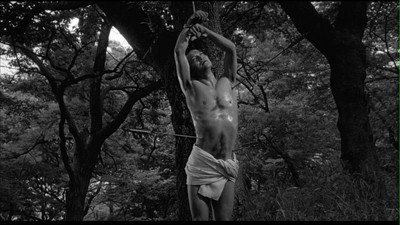
Paul Schrader's 1985 biopic of the Japanese author Yukio Mishima, Mishima: A Life in Four Chapters, is a thoughtful and inventive examination of a writer's life and how it both influences and is influenced by his work. It's a rare case of a willfully arty film that manages to make the question of style over substance immaterial, as they ultimately are one and the same.
As the title suggests, Mishima is broken into four sections, each meant to portray an important stage in the author's life and show the progression of his ideas toward the extreme activist he would eventually become. Each chapter begins with a "present day" sequence that takes place on November 25, 1970, the day Mishima (played by Ken Ogata, recently seen in The Hidden Blade) and four soldiers from his private army, the Shield Society, took a general in the Japanese army prisoner in an attempt to commandeer his troops, overthrow the capitalist government, and return the emperor to the seat of power. When this coup failed to yield results, Mishima committed seppuku, or ritual suicide, rather than see his ideals fizzle. (Some believe this was intention all along, that Mishima never expected the plan to work and was more concerned with setting the stage of a spectacular death.)
From these scenes of Mishima on his way to his mission, Schrader shifts each of the first three chapters into the writer's past. Starting with the boy at age 5 (Yuki Nagahara) and working his way forward into his teen years, and then into his artistic triumphs and adulthood. The flashbacks are all filmed in black-and-white, which serves to differentiate them from the second stories. In addition to the flashbacks, Schrader also chooses one of Mishima's many novels that best exemplifies that period of the work, and he creates a miniature adaptation of said work.
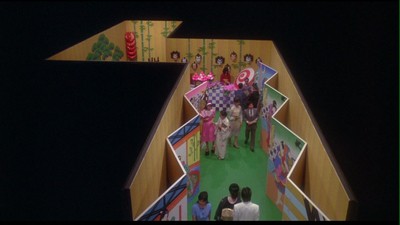
The story begins with chapter 1, "Beauty," where the awkward young boy grows into a man, looking to change his position as a misfit in this world and embrace love and the goodness that life has to offer, the things that are beauty personified. For this section, Schrader chooses to adapt the 1953 novel The Temple of the Golden Pavilion, the story of a Buddhist acolyte (Yasosuke Bando) with a severe stuttering problem whose "deformity" prevents him from finding love, forcing him to always remain separate. He fixates on the golden temple where he is studying and eventually becomes intent on its destruction. Turning it to rubble blots out the false promise he can never fulfill. This action actually teaches him something about beauty, about how it's best to halt it at its apex rather than let age diminish its luster.
From there, Schrader moves to chapter 2, "Art," where Mishima, tasting his first blush of success, begins to ponder how to resolve the false and finite nature of beauty and realize the artist's purpose of preserving said beauty. In his novel Kyoko's Place a young actor turned body builder (Kenji Sawada) realizes that despite his personal perfection, bodies decay. Art is nice, but it requires no sacrifice. He enters into an abusive relationship with a female gangster (Setsuko Karasuma) who begins to use his body as a living sculpture. Real blood is a greater expression of true beauty and art than the false blood spilled on a theatrical stage.
This lesson informs chapter 3, "Action," where Mishima begins to question his role in the world. Words can express ideas, but like how beauty without art fades, so too do ideas go nowhere without action to back them up. The novel for this section is Runaway Horses, a later work about a young soldier (Toshiyuki Nagashima) who forms a cabal of like-minded youths to stage a revolution and restore Japan's honor. As his plan falls apart, he tries one last action before turning his sword on himself. Here the fiction dovetails nicely with the reality, as we go into chapter 4, "Harmony of Pen and Sword," which concerns itself entirely with Mishima's last day on Earth, along with commentary taken from his last book of personal writing, Sun and Steel. (Again, fiction gives way to reality--though reality as seen by Yukio Mishima.)
Each of the novel adaptations is filmed in a colorful, abstract style that borrows from classical and contemporary theatre. Golden Pavilion is the most abstracted, with the sets being obvious facades, while Kyoko reflects a more neon and illusory 1950s. As Schrader moves the timeline forward, each style gets a little more realistic, until it collides with the reality of Mishima's story and the actions of the Shield Society. All of the chapters show the parallels between the writer's life and his fictions, with his childhood struggles to be understood transforming into the acolyte's stuttering, his destruction of canonized literary stylizations being his razing of the Golden Pavilion. So, too, is he later a stage actor, a body builder, and the revolutionary soldier, as the man of letters wrestles with his self-image and the truth of his self-expression.
It's as deep as I've seen anyone go into the life of an artist, certainly multiple steps up from the overly obvious moments of inspiration we see in modern biopics of creative types of various stripes. Schrader and his co-writers, Leonard Schrader (his brother) and the Japanese adapter Chieko Schrader (his sister-in-law), are searching for the true connections, going beyond the standard tale of one life and digging deep into material to show how the writer lives many different existences. He borrows from real events to inform his fiction, but then must alter his life to live up to the ideal he created for himself.
Through it all, Mishima's obsession with death is clear. From his missed opportunity to die for his country in WWII (his own surprising cowardice haunting him ever since) and his study of samurai texts, he begins to dream of an exit that has greater meaning than passing away from old age while home in bed. If action is the only way to give ideas true meaning, then the final action must matter, too.
Though ostensibly an American production--Mishima was produced by George Lucas and Francis Ford Coppola for Coppola's Zoetrope Studios--the film was shot entirely in Tokyo using Japanese actors speaking Japanese. The distinctive costume and production design was also by a Japanese artisan, Eiko Ishioka, who prior to this had worked in mediums other than film, but has since gone on to design costumes for Bram Stoker's Dracula and The Cell, among others. She brings a special flare to the novel sequences, creating an alternate reality in keeping with Yukio Mishima's unique vision. The author's estate initially cooperated with the production, but later withdrew their support over objections of depictions of Mishima's sexuality. Likewise, the Japanese government didn't like seeing the writer's rebellion glamorized, and so the film has never been released theatrically or on video in Japan. (Though, oddly, it can be show on TV, but only with the homosexuality censored.)
It's a bizarre contradiction. The author's work is still venerated in his home country, so why must his life be taboo? Could the irony be that in the act Mishima saw as his final achievement of his artistic ideal, he actually boomeranged back to being the outcast?
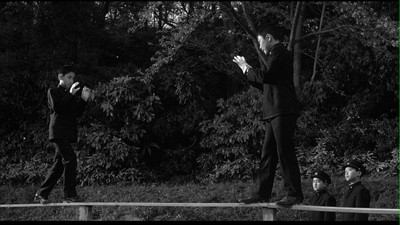
Criterion releases Mishima: A Life in Four Chapters as a double-disc set in conjunction with its separate release of the short film Mishima wrote, directed, and starred in himself. 1966's Patriotism adapts a short story he wrote about a soldier and his wife committing seppuku in 1936, and two scenes about the filming and release of Patriotism are included in Mishima. For information about Patriotism, read the review by DVD Talk's Jeffrey Kaufman or check out my own take at my blog.
THE DVD
Video:
Though Mishima was released on DVD by Warner Bros. in 2001, it has been out of print for some time. We reviewed the disc at the time and gave it very high marks. There have been some changes made between the transfer seven years ago and the new one, however, some of which will be up to debate as far as what some people might prefer, but all of which are approved by Paul Schrader and cinematographer John Bailey, so ultimately you'll have to take it up with them.
The most notable change, and the one that should make just about everyone happy is that the old transfer was a 1.75:1 aspect ratio, and the Criterion disc restores the film to its original ratio of 1.85:1, meaning more information now appears on screen. There have been some color changes and digital enhancements made to some scenes on Schrader's insistence, and these will only be noticeable to those who know the old DVD by heart. Overall, I thought this transfer looked pretty good, with the distinctive color schemes popping in all the right ways and none of the pixilation that sometimes marred the older release.
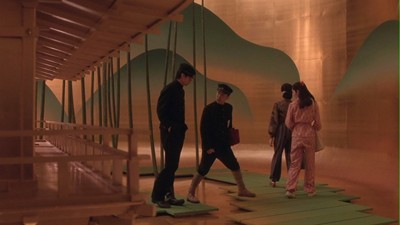
2001
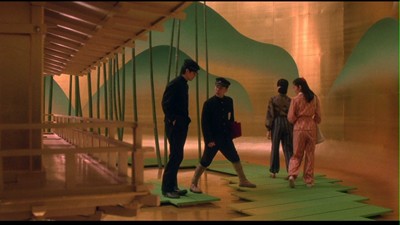
2008
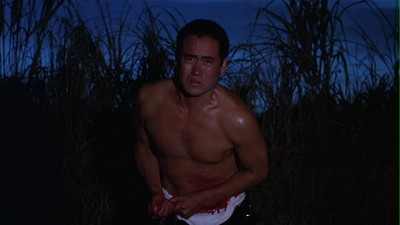
2001
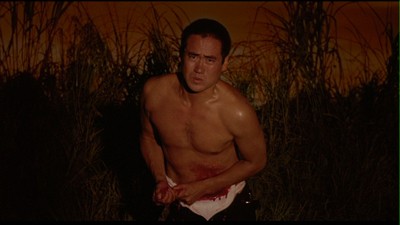
2008
Overall, I think the colors of the movie pop way more in the new version, while the old one looks faded and grainy by comparison.
Sound: The original Japanese soundtrack has been mixed in Dolby Digital stereo and sounds very good. Philip Glass' marvelous score for the picture is the true test of any mix of this movie, and his orchestration rings through loud and clear. There are removable English subtitles throughout.
There are a couple of alternate audio options for viewers to choose from. There were several versions of the narration recorded for the movie. The default option is the Japanese language narration, but you can also choose the late Roy Scheider's English voiceover that was included in the theatrical release or the somewhat different voiceover Paul Schrader recorded as a guide track for Scheider, with actor Paul Jasmin providing the vocals (according to the DVD menu, the Scheider version is available on DVD for the first time on this set).
Extras:
Despite there being two discs in the Mishima: A Life in Four Chapters - Criterion Collection and a pile of supplements, you should know right now that the extras from the 2001 disc are not included here. That includes a documentary about the making of the movie (which was only ten-and-a-half minutes long) and the old audio commentary by Paul Schrader. Most likely this was a rights issue, and though the rights to the film changed hands, the old owners kept the license on the extras. There was also one brief deleted scene from Golden Pavilion where Mizoguchi speaks to his Zen master, which has now been added back into the film.
The old commentary is replaced by a new commentary track featuring Schrader and producer Alan Poul. The two men recorded the audio together, discussing the movie, including specific shot details and the wider scope of the complicated production, including background and reaction to the movie. Schrader goes deep into the storytelling technique, explaining what it was he was trying to do with the three-planed structure of the movie. He and Poul also have many great anecdotes about the challenges of the production, including trying to explain to Ken Ogata how to walk so that his butt looked like John Wayne's when the Duke walks away.
Strangely, Schrader doesn't seem to know the deleted scene is going to be restored in the new commentary. But then, from the talk in regards to the color changes he has decided to make in the Runaway Horses segment, he hasn't gone back into the film yet and hasn't worked out entirely what he can get away with.
The only other bonus on DVD 1 is the original theatrical trailer.
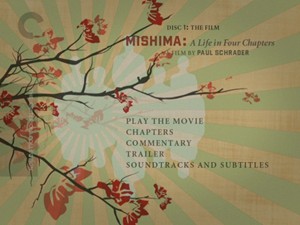
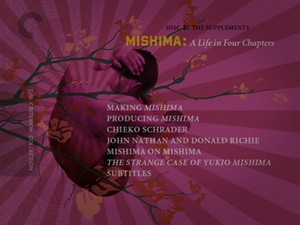
DVD 2 nothing but extras. The lead on the disc is a 44-minute documentary, "Making Mishima," that is a collection of new interviews with cinematographer John Bailey, composer Philip Glass, and designer Eiko Ishioka. Given the uniqueness of the production, these three often worked in tandem and were highly influential on Schrader's choices. There is also much discussion about working in Japan and the suspicion they encountered from the Japanese film industry. This feature includes some on-set footage, photographs, and production designs.
Other new interviews are presented separately as the 22-minute "Producing Mishima," featuring producers Tom Luddy and Mataichiro Yamamoto, who represented both sides of the international production. They speak about the history and genesis of the production, as well as about working with the Mishima estate and the controversy following the estate splitting from the project. This featurette also has photos, on-set footage, and a short snippet of a press conference to announce the film, including an appearance by Coppola. Finally, there is an audio interview with Chieko Schrader, discussing her views on Yukio Mishima and how she functioned as part of the crew.
The remaining extras focus more on Yukio Mishima himself, beginning with interviews with biographer and translator John Nathan and film historian Donald Richie (26 minutes, 40 seconds), both of whom had met Mishima. They talk about the lasting image of the author that stems both from his work and the character he projected to the world.
Mishima himself speaks in a 6-minute, 1966 French television interview conducted upon the publication of After the Banquet, discussing writing and Japanese literature. The Strange Case of Yukio Mishima (55 minutes), a 1985 BBC documentary from the series Made in Japan, takes a straightforward approach to the author's life with original interviews with admirers and associates sitting alongside archival footage of the man, including some from his plays and news footage of the last day of his life. Selections of Mishima's writing are read by actor John Hurt.
Mishima: A Life in Four Chapters - Criterion Collection is a beautiful art object unto itself. Really, Criterion deserves a round of applause for this one. Designer Neil Kellerhouse, along with co-art director Sarah Habibi, has created a bright, embossed boxed set that is as garishly distinctive as Eiko Ishioka's set design and that also plays on the puzzle element of the movie's structure. The outer slipcase has enough room to hold both the DVD sleeve and the 56-page book that comes in the set. The four-sided gatefold sleeve has two trays for the DVDs and a breakdown of the four chapters of the movie printed on the inside. The book has photos, credits, a new critical essay by Schrader-expert Kevin Jackson, information on the film's ban in Japan, and an on-set account from Eiko Ishioka.
FINAL THOUGHTS:
DVD Talk Collector Series Sometimes a DVD set comes along where the nature of a unique production is matched by an equally extraordinary DVD package. Mishima: A Life in Four Chapters - Criterion Collection is one of those sets. Paul Schrader's biopic of the controversial and provocative Japanese author works on multiple levels to break down the writer's life, to show how much of it is interior and how fact and fiction blend into one another. From the script to the production design and the music, every stage of this production strove for something special. This new double-disc set peels the curtain back further to show us how they achieved what they did and more about the reality of the subject. This is one other art films should emulate when making their way to DVD. Don't just fill the space, but fill it well--a sentiment Yukio Mishima could likely get behind.
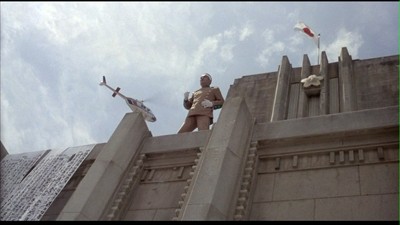
Jamie S. Rich is a novelist and comic book writer. He is best known for his collaborations with Joelle Jones, including the hardboiled crime comic book You Have Killed Me, the challenging romance 12 Reasons Why I Love Her, and the 2007 prose novel Have You Seen the Horizon Lately?, for which Jones did the cover. All three were published by Oni Press. His most recent projects include the futuristic romance A Boy and a Girl with Natalie Nourigat; Archer Coe and the Thousand Natural Shocks, a loopy crime tale drawn by Dan Christensen; and the horror miniseries Madame Frankenstein, a collaboration with Megan Levens. Follow Rich's blog at Confessions123.com.
|
| Popular Reviews |
| Sponsored Links |
|
|
| Sponsored Links |
|
|
| Release List | Reviews | Shop | Newsletter | Forum | DVD Giveaways | Blu-Ray | Advertise |
|
Copyright 2024 DVDTalk.com All Rights Reserved. Legal Info, Privacy Policy, Terms of Use,
Manage Preferences,
Your Privacy Choices | |||||||














